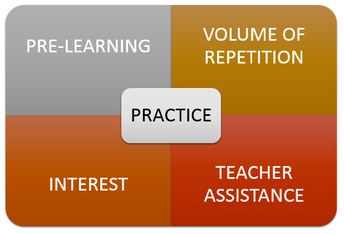3.4. Practicing grammar
3.4.1 Pre-learning
Before starting any practice exercises, teachers need to be sure that the main aspects of the grammar structure have been clearly presented and understood by the students in the previous stage. As it has been seen above one way to ensure this is by the use of questions. Not having this prelearning will simple make the following practice activities too difficult for students forcing teachers to go back over the explanations and losing the normal structure of the lesson.
Remember that student need to understand not only the rules of form, but also the meaning, use and the context in which the grammar structure is applied.
3.4.2. Volume of repetition
Ur explains that “the principle of repetition means that you have to get the learners to produce or perceive examples of the structure over and over again.”
This does not mean a simple repetition of forms,but a number of exercises which try to cover the most important aspects of the target structure giving students the opportunity to rehearse the application of the grammar knowledge acquired in the presentation stage.
3.4.3. Interest
It’s a bit obvious that some practice activities are more interesting than other. For example, simply filling out sentences with the correct verb form might be useful and important, but not as interesting as comparing two pictures in order to find their differences while using present continuous sentences. This is why , all practice activities created by teachers should create motivation and interest on students.
Ur also points out that interest or motivation “in most practice activities has to derive from the intrinsic interest of the activity itself: Its (non-linguistic) topic and the task to be done.
3.4.4. Teacher assistance
Ur adverts that “Teacher activity in the course of practice should therefore be largely directed towards supporting and assisting the students in their production of acceptable responses rather than towards assessing and correcting.”
Teachers can simply provide clues, write words in their conjugated forms, point out ideas on the board, ask guided discovery questions, or give extra time. It is also important to consider that the teacher might want to encourage students by using approval words like good job, nice try, I’m sure you can get it right in the next sentences and so forth. This is so important since learning requires a positive emotional state and many students need to reduce their anxiety.
Before starting any practice exercises, teachers need to be sure that the main aspects of the grammar structure have been clearly presented and understood by the students in the previous stage. As it has been seen above one way to ensure this is by the use of questions. Not having this prelearning will simple make the following practice activities too difficult for students forcing teachers to go back over the explanations and losing the normal structure of the lesson.
Remember that student need to understand not only the rules of form, but also the meaning, use and the context in which the grammar structure is applied.
3.4.2. Volume of repetition
Ur explains that “the principle of repetition means that you have to get the learners to produce or perceive examples of the structure over and over again.”
This does not mean a simple repetition of forms,but a number of exercises which try to cover the most important aspects of the target structure giving students the opportunity to rehearse the application of the grammar knowledge acquired in the presentation stage.
3.4.3. Interest
It’s a bit obvious that some practice activities are more interesting than other. For example, simply filling out sentences with the correct verb form might be useful and important, but not as interesting as comparing two pictures in order to find their differences while using present continuous sentences. This is why , all practice activities created by teachers should create motivation and interest on students.
Ur also points out that interest or motivation “in most practice activities has to derive from the intrinsic interest of the activity itself: Its (non-linguistic) topic and the task to be done.
3.4.4. Teacher assistance
Ur adverts that “Teacher activity in the course of practice should therefore be largely directed towards supporting and assisting the students in their production of acceptable responses rather than towards assessing and correcting.”
Teachers can simply provide clues, write words in their conjugated forms, point out ideas on the board, ask guided discovery questions, or give extra time. It is also important to consider that the teacher might want to encourage students by using approval words like good job, nice try, I’m sure you can get it right in the next sentences and so forth. This is so important since learning requires a positive emotional state and many students need to reduce their anxiety.

